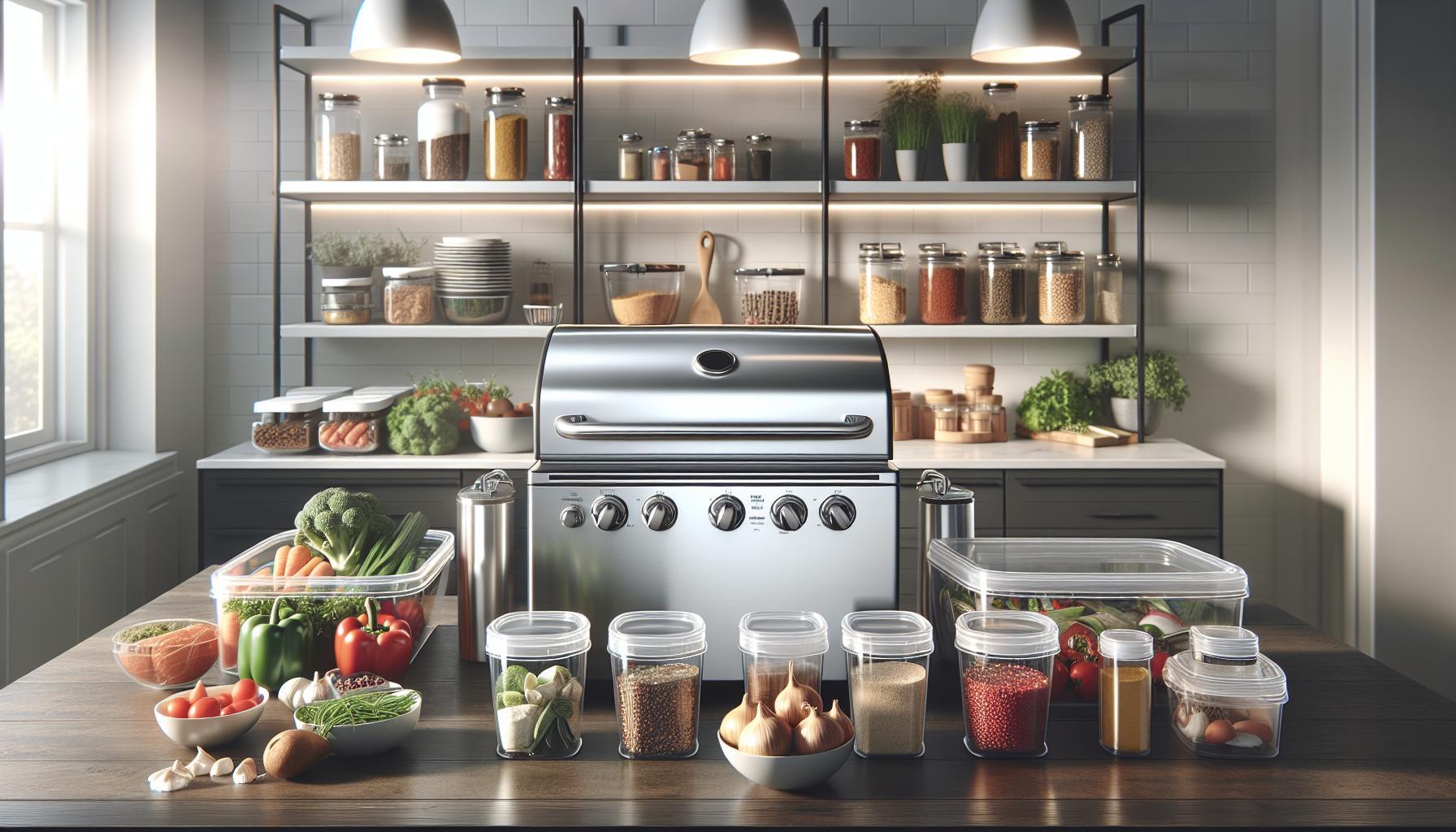Bone broth is a nutrient-rich staple celebrated for its health benefits, but if you’re not careful, its potential can be wasted due to improper storage. Understanding how long bone broth lasts in the fridge is essential for maximizing its freshness and safety, allowing you to enjoy its rich flavors and nutritional value without the worry of spoilage.
Have you ever wondered how to make the most of your homemade broth? Delving into proper storage practices can help ensure you enjoy every last drop safely. This guide will provide you with essential tips and best practices for storing bone broth, so you can savor its goodness for days while maintaining food safety. Curious about how long you can keep that delicious liquid gold? Read on to uncover the secrets to extending the shelf life of your bone broth!
How Long Can Bone Broth Be Stored in the Fridge?
Bone broth is a nourishing culinary staple, but knowing how long it can last in the fridge is crucial for both flavor and safety. Typically, homemade bone broth can be stored in the refrigerator for about 4 to 5 days. If you’re aiming for the best taste and quality, consuming it within this timeframe is advisable. Store-bought varieties may hold a slightly longer shelf life, often indicated on their packaging, but once opened, they should also be consumed within a week.
To maximize freshness, store the bone broth in airtight containers. Glass jars or BPA-free plastic containers are excellent choices as they help maintain the broth’s integrity. Remember to leave some space at the top of the container, as liquids expand when frozen. If you notice any signs of spoilage, such as an off smell or visible mold, it’s best to err on the side of caution and discard the broth.
By keeping track of how long your bone broth has been in the fridge, you’ll ensure that you enjoy all its rich flavors and health benefits safely.
Understanding Bone Broth Freshness and Quality
When stored correctly, bone broth is a flavor-packed and nutritious culinary delight. Understanding what factors influence its freshness and quality will help you enjoy it safely and to its fullest potential. The freshness of bone broth is primarily dictated by its ingredients, preparation methods, and storage conditions. Fresh, homemade bone broth made from high-quality bones and organic vegetables can provide an excellent base for soups, stews, or sipping directly. However, even the best broth can go bad if not handled properly.
One key indicator of bone broth’s freshness is its aroma. Fresh broth typically carries a rich, savory scent, while spoiled broth may emit an unpleasant, off-putting smell. Similarly, the visual appearance matters: bone broth should be clear and free of any visible mold or discoloration. When it comes to taste, a sip of fresh broth should be robust and flavorful. If it tastes sour or otherwise off, it’s best to discard it to avoid foodborne illness.
To help maintain quality, consider the factors that can affect freshness. Keeping broth at consistent, cool refrigerator temperatures is essential; the ideal range is below 40°F (4°C). Preventing exposure to air by using airtight containers can also significantly prolong its lifespan. It’s crucial to note that homemade bone broth generally lasts in the fridge for about 4 to 5 days, while store-bought varieties may last longer, particularly if they remain sealed until opened.
By understanding these aspects of bone broth, you can ensure that you enjoy its health benefits while minimizing waste. Regularly checking for signs of freshness and adhering to recommended storage guidelines will help you make the most of this nutritious staple.
Signs Your Bone Broth Has Spoiled
Determining whether bone broth has gone bad is crucial for both safety and flavor. Fresh bone broth provides numerous health benefits, but consuming spoiled broth can lead to foodborne illnesses. To help you ensure your broth is safe to consume, keep an eye out for the following telltale signs of spoilage.
A significant indicator of spoilage is the broth’s aroma. Fresh bone broth emanates a rich, savory scent, inviting you to use it in your favorite recipes. In contrast, spoiled broth may produce a foul or sour smell that is unmistakable. If you detect any off-putting aromas, it’s a safe bet that the broth should be discarded.
Visual cues are equally important. A fresh batch of bone broth should appear clear and free of any floating particles or cloudiness. Watch for signs of mold, which may appear as green or black spots on the surface. Additionally, discoloration can signal breakdown in quality; any unusual hues or a change from a rich brown to a more muted color can indicate spoilage.
Lastly, taste acts as a final checkpoint. While not recommended as the primary method for checking spoilage, a small taste can provide insight. Fresh broth should be robust and flavorful; if your first sip reveals a sour or strange flavor, it’s best to err on the side of caution and dispose of it.
By being vigilant with these signs-aroma, appearance, and taste-you can enjoy your bone broth confidently and safely, knowing you’re consuming a quality product.
Best Storage Practices for Bone Broth
To ensure your bone broth maintains its freshness and quality, proper storage practices are essential. When stored correctly, bone broth can last in the refrigerator for up to 4 to 5 days, providing you with a nutritious base for soups, stews, and sauces. One crucial factor in maximizing its shelf life is choosing the right container. Use airtight glass jars or high-quality plastic containers that have tight-fitting lids. This prevents air exposure, which can lead to spoilage and off-flavors.
Another effective strategy is to cool the broth quickly before refrigerating it. After cooking, allow the broth to cool at room temperature for no more than two hours. For faster cooling, pour it into smaller containers or use an ice bath. This step helps minimize bacterial growth, ensuring that your broth stays safe for consumption. Additionally, always label your containers with the date to keep track of how long the broth has been stored.
Refrigerator Storage Tips
- Keep it Airtight: Seal your broth in containers that limit air exposure.
- Cool Quickly: Avoid leaving broth at room temperature for an extended period.
- Label and Date: Always note when the broth was made for reference.
If you plan to store bone broth for a more extended period, consider freezing it. Frozen bone broth can last for up to six months without sacrificing flavor or nutrients. Use freezer-safe containers or ice cube trays to portion out your broth, making it easy to thaw only what you need. Always leave some space in your containers when freezing, as liquids expand when frozen.
By adhering to these best storage practices, you can enjoy the health benefits of bone broth safely and effectively, making your culinary endeavors more convenient and delicious.
How to Extend the Shelf Life of Bone Broth
To truly harness the rich, nutritious potential of bone broth, extending its shelf life is essential. By implementing a few straightforward strategies, you can enjoy your homemade broth over an extended period while maintaining its flavor and health benefits. One key approach is to ensure that the broth is stored in optimal conditions; the right environment significantly hinders bacterial activity and spoilage.
Start by cooling your bone broth as quickly as possible before refrigerating it. Transfer the hot liquid into smaller containers, as this allows it to cool faster. If you’re in a hurry, an ice bath can expedite the process remarkably, minimizing the time the broth spends at room temperature. Aim to refrigerate the broth within two hours of cooking to inhibit the growth of harmful bacteria. Additionally, use airtight containers, whether glass jars or high-quality plastic, to limit exposure to air, which can lead to oxidation and a decline in taste.
When it comes to freezing, this is one of the best methods to extend the shelf life of bone broth significantly. You can portion your broth into ice cube trays or freezer bags for easy access when needed. Frozen broth can last up to six months without compromising its quality. Remember to leave some space in your containers or bags, as liquids expand when frozen. Properly label everything with the date you made it to keep track of its age and ensure you use it before any potential decline in quality occurs.
Key Tips for Extending Shelf Life
- Cool Quickly: Transfer broth to smaller containers or an ice bath to reduce temperature swiftly.
- Airtight Storage: Use containers that prevent air exposure to maintain flavor.
- Freeze for Longevity: Portion out broth for freezing and label with dates for easy reference.
By incorporating these practices, you can maximize the usefulness of your bone broth while ensuring it remains a safe, delicious option for your culinary needs. Remember, proper storage not only extends shelf life but also enhances your overall cooking experience.
Freezing Bone Broth: A Complete Guide
Freezing bone broth is an excellent way to extend its shelf life while preserving its nutritional benefits and flavor. By properly freezing your broth, you can enjoy its rich and savory goodness for several months without the worry of spoilage. When it comes to freezing, preparation is key. Always allow your bone broth to cool to room temperature before freezing to prevent ice crystals from forming, which can alter its texture and taste. Ideally, refrigerate the broth first until cool, then transfer it to your desired freezing containers.
For convenience, consider portioning your broth into smaller quantities. Ice cube trays are fantastic for this, allowing you to freeze individual servings that can be easily thawed as needed. Once the broth is frozen solid, transfer the cubes to a freezer-safe bag or container. Not only does this save space, but it also makes it easier to defrost only what you need without having to thaw the entire batch. Remember to label each bag or container with the date, as frozen bone broth is best consumed within six months for optimal flavor and quality.
Best Practices for Freezing Bone Broth:
- Use Airtight Containers: To prevent freezer burn, make sure that the containers are airtight. Glass jars, freezer bags, or vacuum-sealed bags all work well.
- Leave Space for Expansion: Liquids expand when they freeze; therefore, leave some room at the top of your container to accommodate this expansion.
- Cool First, Then Freeze: Always let the broth cool completely before freezing it. This helps maintain its integrity and flavor.
When you’re ready to use your frozen broth, the safest method is to defrost it in the refrigerator overnight or place the sealed container in a bowl of warm water for a quicker thaw. While it’s tempting to microwave for convenience, rapid heating can degrade the quality and nutrient content of the broth. Following these guidelines will ensure that you can enjoy your bone broth at its best, even months after preparing it.
Using Bone Broth After Its Expiration Date
requires careful consideration and a few safety checks to ensure its quality and safety. While it’s common for food items to have a “best by” date, this does not always signify that the bone broth is immediately unsafe to consume after that date. In many cases, homemade bone broth can last for a bit longer if stored properly, but evaluating its condition is essential before use.
First, assess the broth visually and by smell. If you notice any changes in color or a foul odor, it’s best to discard it. Additionally, check for any signs of mold or an off texture. If the broth appears cloudy or sediment has formed, it’s worth considering that the flavors and nutrients may not be at their best, even if it’s not harmful. As a rule of thumb, bone broth stored in the refrigerator is generally safe for about 4-5 days after cooking, but it’s crucial to use your judgment. Always prioritize food safety to avoid any risk of foodborne illnesses.
If you determine that the broth is still okay to use, consider cooking it again. Bringing it to a boil can help kill off potential bacteria, although this doesn’t guarantee all harmful bacteria are eliminated, especially if spoilage has already occurred. Doing so also revitalizes the flavors, which might have mellowed out over time. If the broth is past its expiration but meets safety checks, infusing it in new recipes or cooking it with fresh ingredients can enhance its appeal, making it a valuable addition to soups, stews, or risottos.
Ultimately, understanding the signs of spoilage and being aware of the storage practices allows for smart choices about using bone broth past its expiration date. Keeping track of when you made the broth and how you’ve stored it can significantly impact its shelf life and quality. Always err on the side of caution and remember that when in doubt, throwing it out is the safest option.
Reheating Bone Broth Safely and Effectively
Reheating bone broth is a straightforward process, yet one that requires careful attention to ensure safety and preservation of flavor. When reheating, achieving an appropriate temperature is crucial to eliminate any potential bacteria that may have developed during storage. The USDA recommends heating foods to an internal temperature of at least 165°F (74°C) for safe consumption. This guideline applies to bone broth, as it helps kill any harmful microorganisms that could pose health risks.
To reheat broth effectively, consider these methods:
- Stovetop: Pour the broth into a saucepan and heat over medium heat. Stir occasionally to promote even heating and prevent sticking. Bring the broth to a rolling boil for at least one minute to ensure safety.
- Microwave: Place the broth in a microwave-safe container. Heat on high for 1-2 minutes, checking and stirring halfway through to ensure even heating. Again, ensure the broth bubbles vigorously to reach a safe temperature.
- Slow Cooker: For a more gradual reheating, transfer the broth to a slow cooker on a low setting. This method is ideal for those who want to savor the flavors without rush. Just make sure it reaches the recommended temperature before serving.
Once reheated, consider enhancing the broth with fresh ingredients. Adding fresh herbs, a splash of vinegar, or even diced vegetables can revitalize the flavor profile, making it even more enjoyable. If the broth has been previously frozen, it’s best to thaw it in the refrigerator overnight before reheating. Never reheat multiple times; doing so increases the risk of foodborne illness and can degrade the taste and quality of the broth.
By following these practices, you can safely enjoy your homemade bone broth, making the most of its nutritional benefits while ensuring it remains a delicious addition to your meals. Remember, always prioritize food safety and quality to fully appreciate the rich flavors and health perks of your bone broth.
Nutritional Benefits of Properly Stored Bone Broth
Bone broth is not just a comforting staple; it is a nutrient-dense elixir that offers an array of health benefits, especially when properly stored. One of the key advantages of properly stored bone broth is that it retains its high nutritional quality, which can be greatly beneficial for your health. For optimum freshness, homemade bone broth can typically last in the refrigerator for 3 to 5 days. However, its health benefits diminish significantly once it begins to spoil. Therefore, recognizing the importance of storage techniques is essential to maximize its value and your overall wellbeing.
When bone broth is stored correctly, it provides vital nutrients, including collagen, gelatin, amino acids, and minerals. Collagen, as a protein, can support joint health and improve skin elasticity, while the gelatin found in broth supports digestion by promoting a healthy gut lining. Additionally, the amino acids present in bone broth, such as glycine and proline, have been associated with anti-inflammatory properties and can support sleep quality.
To ensure that you reap these benefits, it’s crucial to adhere to best storage practices. Always use airtight containers to minimize exposure to air, which can lead to oxidation and spoilage. Keeping the broth in the coldest part of your fridge will also help extend its shelf life. For longer preservation, freezing bone broth is an excellent option, allowing it to maintain its nutritional properties for several months.
Ultimately, when stored properly, bone broth can serve as a versatile ingredient in your diet, contributing to your nutrition in delicious and creative ways. Whether you sip it warm, use it as a base for soups, or enhance sauces, the key is to ensure it’s fresh and safe for consumption to fully enjoy its array of health benefits.
Common Mistakes When Storing Bone Broth
Storing bone broth properly is crucial to maintaining its nutritional benefits and ensuring safety for consumption. Unfortunately, several common mistakes can lead to spoilage or loss of flavor and nutrients. By understanding and avoiding these pitfalls, you can extend the life of your bone broth while enjoying its many health advantages.
One of the most frequent errors is failing to cool bone broth quickly before refrigerating it. Leaving warm broth at room temperature allows bacteria to thrive, potentially leading to foodborne illness. Always aim to cool your broth as quickly as possible, ideally in shallow containers that promote even cooling. Once cooled, store it in airtight containers to prevent exposure to air, which can lead to oxidation and spoilage.
Another common mistake is not labeling containers with the date of storage. This oversight makes it challenging to track freshness. Proper labeling not only helps you monitor how long the broth has been stored but also aids in maintaining a rotation system in your fridge-moving older items to the front for use. Aim to consume homemade bone broth within 3 to 5 days for optimal freshness and safety.
Lastly, many people neglect to check the temperature of their refrigerator. Bone broth should be stored in the coldest part of your fridge, ideally below 40°F (4°C). If your fridge is too warm, it accelerates spoilage. Investing in a refrigerator thermometer can help ensure that your appliance maintains the proper temperature to keep your broth fresh for as long as possible. By avoiding these common mistakes, you can drastically improve the quality and longevity of your homemade bone broth.
Bone Broth vs. Store-Bought: Shelf Life Comparison
When comparing homemade bone broth to store-bought options, one significant factor to consider is shelf life. Homemade bone broth typically lasts in the refrigerator for about 3 to 5 days when stored properly, though some recipes may recommend using it within 4 days for optimal quality. This relatively short shelf life is largely due to the absence of preservatives and the more careful handling required when making it at home.
On the other hand, store-bought bone broth often boasts a longer shelf life due to the inclusion of preservatives and packaging methods such as aseptic or vacuum-sealed containers. Unopened, it can last up to a year on the shelf, with some brands specifying that once opened, the broth should be consumed within 4 to 7 days. This longer shelf life can be a convenience for busy individuals or families who may not use bone broth frequently.
However, it’s important to consider quality alongside shelf life. Homemade bone broth often has a richer flavor and more nutrients, as it is typically made with high-quality ingredients and cooked over a long period. In contrast, many store-bought varieties may lack the depth of flavor or nutritional profile found in homemade versions. To get the best of both worlds, consider making a large batch of bone broth and freezing the portions you won’t consume within the first few days. This way, you can enjoy the benefits of homemade broth while extending its usability significantly.
In summary, while store-bought options are convenient and have a longer shelf life, nothing quite matches the quality and freshness of homemade bone broth. Make sure to keep proper storage practices in mind for both methods to ensure safety and taste.
Frequently asked questions
Q: How can I tell if my bone broth has gone bad?
A: To determine if your bone broth has spoiled, check for off smells, visible mold, or a sour taste. Additionally, if the broth has changed color or appearance significantly, it’s best to discard it. Always practice safe food handling to avoid any health risks.
Q: Can I extend the shelf life of bone broth in the fridge?
A: Yes, you can extend the shelf life of bone broth by storing it in an airtight container and keeping it in the coldest part of your fridge. Adding a layer of fat on top can also help preserve freshness. For long-term storage, consider freezing the broth.
Q: What is the best way to reheat bone broth?
A: The best way to reheat bone broth is on the stovetop over low heat to maintain its nutrients. Alternatively, you can use a microwave, but do so in short intervals, stirring in between to ensure even heating. Always heat until it reaches a rolling boil to ensure safety.
Q: How long can bone broth be left out at room temperature?
A: Bone broth should not be left out at room temperature for more than two hours. Bacteria can multiply rapidly at room temperatures, making the broth unsafe to consume if left unrefrigerated for too long.
Q: Is it safe to use bone broth past its expiration date?
A: Using bone broth past its expiration date can pose health risks. If properly stored and without signs of spoilage, it may still be safe, but it’s best to err on the side of caution. Always perform a smell and taste check before using.
Q: How should I store homemade bone broth?
A: Store homemade bone broth in airtight containers, allowing some space for expansion if freezing. Refrigerate for up to a week or freeze for up to six months. Labeling containers with the date can help manage storage time effectively.
Q: Can bone broth be canned for longer storage?
A: Yes, bone broth can be canned, but it must be pressure canned to ensure safety. Home canning requires following specific guidelines to prevent contamination and ensure long-term preservation. Always consult reliable sources before canning.
Q: Are there different types of bone broth and do they have different shelf lives?
A: Yes, different types of bone broth, such as beef, chicken, or vegetable, can vary slightly in shelf life based on their ingredients and fat content. Generally, all bone broths can last 3-4 days in the fridge and longer if frozen.
In Conclusion
In summary, understanding how long bone broth lasts in the fridge is crucial for maximizing its shelf life and ensuring food safety. Remember, homemade bone broth generally stays fresh for up to a week when stored properly. Need more tips on flavor enhancements or storage methods? Check out our guides on “Storing Homemade Soups” and “Flavoring and Varieties of Bone Broth” for additional insights.
Don’t let your hard work go to waste-make a plan to use or freeze your broth within that timeframe! Have questions or tips of your own? Share them in the comments below or reach out to our community. For more food safety tips and delicious recipes, consider subscribing to our newsletter. Join our culinary journey and never miss out on tasty ideas that elevate your kitchen game!





